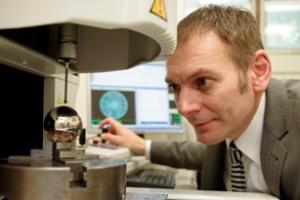News
BBC Newsnight and BMJ Investigate hip failures

BBC Newsnight programme and the British Medical Journal have joined forces to investigate metal-on-metal hip joint replacment and feature our work at Newcastle University in a major article and a TV feature. The Newsnight feature is due to be aired 28 February, BBC 2, 22.30.
BMJ Press Release
Joint BMJ / BBC Newsnight investigation raises new concerns over metal hip implants, which may affect more people than the breast implants scandal
Hundreds of thousands of people around the world may have been exposed to dangerously high levels of toxic metals from failing hip implants, despite the risks being known and documented for decades, warns a joint BMJ / BBC Newsnight investigation published today.
Hip implants, like breast implants did not have to pass any clinical trials before they were put into patients.
The investigation reports how cobalt and chromium ions can seep into the tissues of patients with “metal on metal” (MoM) hip implants, causing local reactions that destroy muscle and bone, and leaving some patients with long term disability. Studies have also shown that metal ions can leach into the bloodstream, spreading to the lymph nodes, spleen, liver and kidneys, before leaving the body as urine. There are also concerns about damage to chromosomes, leading to genetic changes.
Local tissue reactions associated with metal ions were first described in detail as long ago as 1975. Yet the investigation reveals how manufacturers remained silent in the face of mounting evidence of risk, and how the regulatory bodies failed to act to protect patients.
Full details will be published on the BMJ website and broadcast on BBC Newsnight on Tuesday 28 February 2012.
"This is one very large uncontrolled experiment exposing millions of patients to an unknown risk. We will only find out about the safety of these devices after large numbers of people have already been exposed," says Michael Carome, Deputy Director of Public Citizen's Health Research Group.
The investigation also shows how companies have changed the design of their metal hips over the last decade (making the “head” larger and part of the “stem” shorter) in a bid to prevent dislocation and increase movement, without conducting new trials to demonstrate safety and effectiveness or post-marketing studies to detect any long-term problems.
Experts say it is likely that these design changes are responsible for the release of high levels of toxic metals into the body, yet regulators in the US and Europe failed to spot the changes, and despite concerns being raised, failed to warn doctors and patients of the potential dangers.
One design change was cleared by the US regulator, the FDA, who said the design “does not raise any new issues of safety or effectiveness.”
As early as 2006, evidence was mounting about high metal concentrations in patients with articular surface replacement (ASR) hips. But it was another four years until the UK regulator, the MHRA, issued an official safety alert and the ASR hip was recalled from the market.
Instead, the MHRA, appointed a committee that included company representatives and several consultants to decide the fate of metal on metal hips. As a result, they concluded that patients should be told about the risks, but no alert was issued to surgeons or patients.
The MRHA also downplayed the problems, stating: “The majority of patients implanted with MoM hip replacements have well-functioning hips and are thought to be at low risk of developing serious problems.”
During this time, implant rates peaked. In England and Wales over 20,000 large diameter metal on metal hips were implanted thereafter, while in the US, metal on metal hips are still being marketed to orthopaedic surgeons.
The British Standards Institution (BSI) even gave one metal on metal system (the Pinnacle system, manufactured by Depuy) their quality “kitemark” in 2009 and 2010. When the BMJ asked BSI if they knew of concerns about the design at the time, they said they were “bound by strict obligations of confidentiality to our clients.”
Nick Freemantle, Professor of Clinical Epidemiology and Biostatistics at University College London says: “We shouldn’t be in this position where we don’t know and there’s so much uncertainty. The stability of a compound should have been ascertained before it was used widely in people. As yet, we don’t know the consequences of this.”
Dr Fiona Godlee, BMJ Editor in Chief says: “Hip replacements are one of the great successes of modern medicine. But a combination of inadequate regulation and untrammelled commercialism has caused actual and potential harm for large numbers of patients around the world. They should have known about the risks, as the manufacturers and regulators did, but they were not told."
"No pre-market system can ensure all devices are safe, but they can certainly make it more likely,” add Dr Carl Heneghan and colleagues in an accompanying article. “Creating an independent system for post-marketing analysis for implantable medical devices that is robust and increasing international coordination around device alerts and withdrawals should go some way to sorting out the current mess."
Contacts:
Deborah Cohen, Investigations Editor, BMJ, London, UK
Tel: +44 (0)20 7383 6183
Email: dcohen@bmj.com
Dr Tom Joyce, Reader in Biotribology, School of Mechanical and Systems Engineering, Newcastle University, UK
Tel: +44 (0)191 222 6214
Email: Thomas.joyce@ncl.ac.uk
Dr Carl Heneghan, Director of the Centre for Evidence-Based Medicine & Clinical Reader, University of Oxford, UK
Tel: +44 (0)1865 289 299
Email: carl.heneghan@phc.ox.ac.uk
Tony Nargol, Orthopaedic Surgeon, University Hospital of North Tees, Hartlepool, UK
Tel (via Claire Young, Press Officer): +44 (0)1642 624 339
Email: Claire.Young@nth.nhs.uk
Nick Freemantle, Professor of Clinical Epidemiology and Biostatistics, University College London, UK
Email: nicholas.freemantle@ucl.ac.uk
Last modified: Wed, 29 Feb 2012 12:23:01 GMT